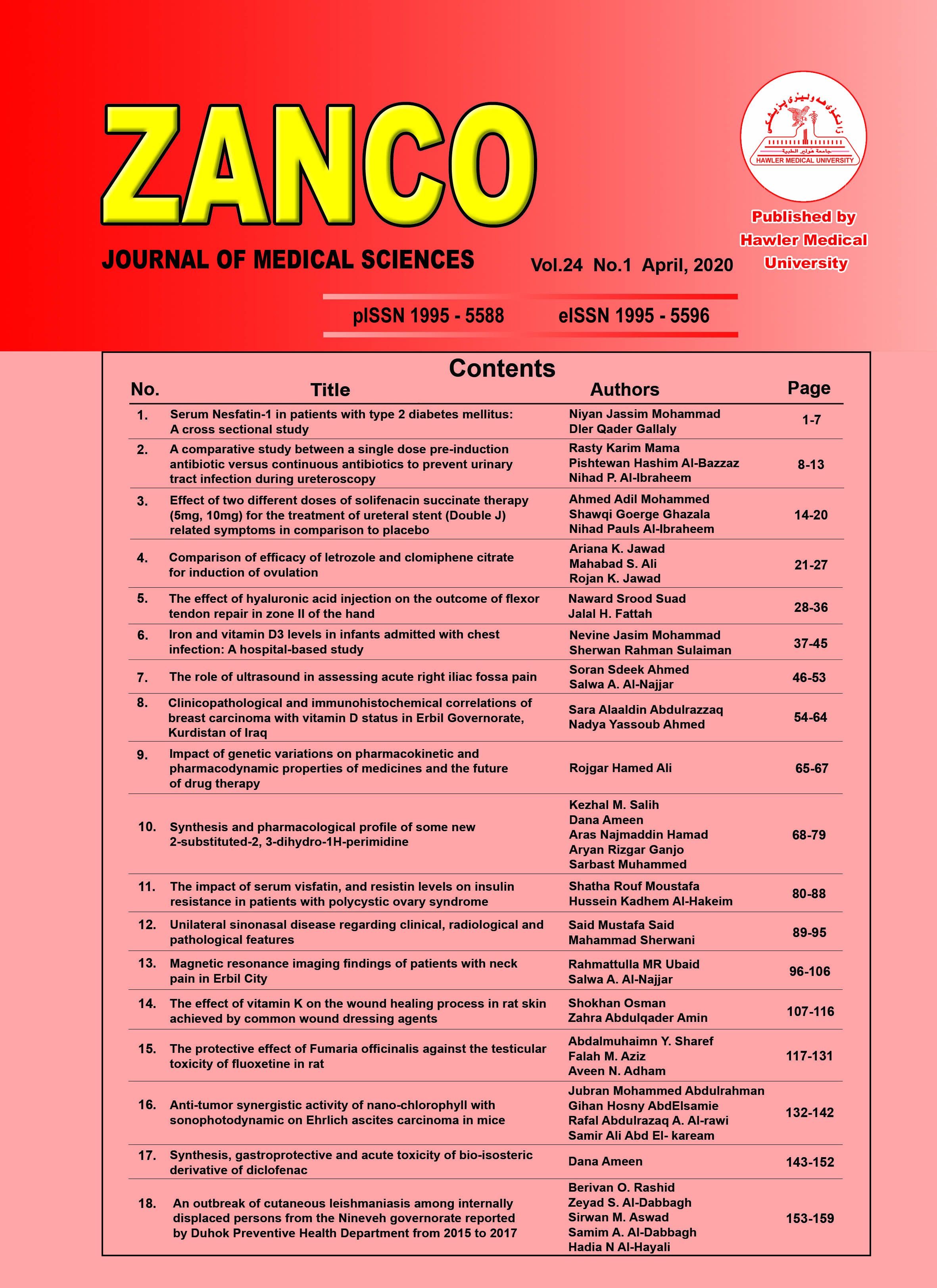The effect of hyaluronic acid injection on the outcome of flexor tendon repair in zone II of the hand
Copyright (c) 2020 Naward Srood Suad, Jalal H. Fattah (Author)

This work is licensed under a Creative Commons Attribution-NonCommercial-ShareAlike 4.0 International License.
- Articles
- Submited: June 2, 2020
-
Published: April 30, 2020
Abstract
Background and objective: Flexor tendon injuries of the hand are common, especially in zone II. Various pharmacologic agents have been used to improve the outcome of primary tendon repair. One must select an option that accomplishes an excellent total active movement of the repaired tendon. This study aimed to find out the effect of hyaluronic acid injections in the restoration of normal gliding and power of the repaired tendon.
Methods: An interventional study of 47 cases of zone II flexor tendon injury managed from May 2017 to May 2018. The data were assembled in a questionnaire. Standardized photographs for pre-, intra-, and postoperative were taken. Hyaluronic acid injections were used in selected cases.
Results: Sharp injury (34 cases, equal to 72%) was found to be the commonest mechanism of flexor tendon injury. Male predominance was noticed (38 cases out of 47) due to their working nature. The hyaluronic acid injection was delivered to selected cases (10 cases, equal to 21%) based on preoperative evaluation. Eighty percent of repairs regained total active movement uneventfully. Few complications happened which responded to conservative management. The P value of total active movement in relation to hyaluronic acid injection was 0.036, which is considered statistically significant.
Conclusion: This study shows that intraoperative injection of high molecular weight of hyaluronic acid improves the outcome of flexor tendon repair, presumably by decreasing the chance of adhesion.
Metrics
References
- Tang JB. Release of the A4 pulley to facilitate zone II flexor tendon repair. J Hand Surg Am 2014; 39(11):2300–7.
- Newmeyer WL, Manske PR. No man’s land revisited: the primary flexor tendon repair controversy. J Hand Surg Am 2004; 29(1):1–5.
- Seiler JG. Flexor tendon repair. Journal of American society for surgery of the hand 2001; 1(3):177–91.
- Tsai WC, Hsu CC, Chen CP, Chen MJ, Lin MS, Pang JH. Ibuprofen inhibition of tendon cell migration and down-regulation of paxillin expression. J Orthop Res 2006; 24:551–8.
- Nishida J, Araki S, Akasaka T, Toba T, Shimamura T, Amadio PC. Effects of hyaluronic acid on the excursion resistance of tendon grafts. A biomechanical study in a canine model in vitro. J Bone Joint Surg Br 2004; 86:918–24.
- Golash A, Kay A, Warner JG, Peck F, Watson JS, Lees VC. Efficacy of ADCON-T/N after primary flexor tendon repair in zone II: a controlled clinical trial. J Hand Surg Br 2003; 28:113–5.
- Necas J, Bartosikova L, Brauner P, Kolar J. Hyaluronic acid (hyaluronan): a review. Veterinarni Medicina; 2008; 53:397–411.
- Tuncay I, Ozbek H, Atik B, Ozen S, Akpinar F. Effects of hyaluronic acid on postoperative adhesion of tendon calcaneus surgery: an experimental study in rat. J Foot Ankle Surg 2002; 41:104–8.
- Ozgenel GY, Samli B, Ozcan M. Effects of human amniotic fluid on peritendinous adhesion formation and tendon healing after flexor tendon surgery in rabbits. J Hand Surg Am 2001; 26:332–9.
- Jubb RW, Piva S, Beinat L, Dacre J, Gishen P. A one-year randomized, placebo (saline) controlled trial of 500-730kDa sodium hyaluronate (Hyalgan) on the radiological change in osteoarthritis pf the knee. Int J Clin Pract 2003; 57:467–74.
- Shu XZ, Ghosh K, Liu Y, Palumbo FS, Luo Y, Clark RA. Attachment and spreading of fibroblasts on an RGD peptide-modified injectable hyaluronan hydrogel. J Biomed Mater Res A 2004; 68(2):365–75.
- Riccio M, Battiston B, Pajardi G. Efficiency of hyaloglide in the prevention of the recurrence of adhesions after tenolysis of flexor tendons in zone II: a randomized, controlled, multi Centre clinical trial. J of Hand Surg Eur 2010; 35(2):130–8.
- Nandi A, Estess P, Siegelman MH. Hyaluronan anchoring and regulation on the surface of vascular endothelial cells is mediated through the functionally active form of CD44. J Biol Chem 2000; 275(20):14939–48.
- Karakurum G, Buyukbebeci O, Kalender M Gulec A. Seprafilm interposition for preventing adhesion formation after tenolysis: an experimental study on the chicken flexor tendons. J Surg Res 2003; 113:195–200.
- Finger injuries and treatment. 2009. (Accessed June 4, 2018, at https://rockrun.world/blogs/how-to-guides/finger-injuries-and-treatment).
- Ozgenel GY, Etoz A. Effects of repetitive injections of hyaluronic acid on peritendinous adhesions after flexor tendon repair: a preliminary randomized, placebo-controlled clinical trial. Ulus Travma Acil Cerrahi Derg 2012; 18(1):11–7.
- Menderes A, Mola F, Tayfur V, Vayvada H, Barutcu A. Prevention of peritendinous adhesions following flexor tendon injury with suprafilm. Ann Plast Surg 2004; 53:560–4.
- Nitzan DW, Nitzan U, Dan P, Yedgar S. The role of hyaluronic acid in protecting surface active phospholipids from lysis by exogenous phospholipase A2. Rheumatology: British society for Rheumatology 2001; 40(3):336–40.
- Wiig ME, Dahlin LB, Fridén J, Hagberg L, Larsen SE, et al. PXL01 in Sodium Hyaluronate for Improvement of Hand Recovery after Flexor Tendon Repair Surgery: Randomized Controlled Trial. PLoS ONE 2014; 9(10):e110735.
- Khanna A, Friel M, Gougoulias N, Longo UG, Maffulli N. Prevention of adhesions in surgery of the flexor tendons of the hand: what is the evidence? Br Medi Bull 2009; 90:85–109.
- Corradi M, Bellan M, Frattini M, Concari G, Tocco S, Pogliacomi F. The four-strand staggered suture for flexor tendon repair: in vitro biomechanical study. J Hand Surg Am 2010; 35:948–55.
- Elliot D. Primary flexor tendon repair –operative repair, pulley management and rehabilitation. J Hand Surg Br 2002; 27:507–13.
- Strickland JW. Development of flexor tendon surgery: twenty-five years of progress. J Hand Surg 2000; 25A:214–35.





